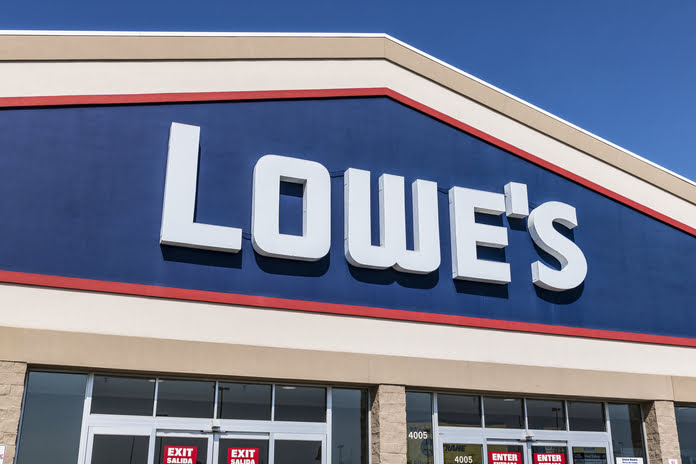When dividend stocks are trading at low levels as opposed to high levels, it is preferable to purchase them. This is due to the fact that obtaining an attractive beginning yield and value is essential to generating long-term returns that outperform the market.
That brings us to Lowe’s (NYSE:LOW), which is still a value stock, especially given the company’s high caliber. We’ll be highlighting in this article what makes this dividend stock a wise investment right now, so let’s get started.
Why Lowe’s is a Great Buy
With approximately 2,000 locations in North America, Lowe’s is the second-largest home improvement retailer in the world, only behind Home Depot (NYSE:HD) (U.S. and Canada). While retail “do it yourself” customers make up the majority (75%) of its sales, the company also generates a sizable amount of revenue from commercial and professional clients, who make up the final 25% of sales.
Since the year’s beginning, shares of Lowe’s have lost a whopping 25%. This is partly because the property market has been significantly slowed down by rising rates, which have also impacted consumer spending and hit LOW hard. The stock is currently trading at $191.53, which is significantly less than the $263 52-week high it reached at the end of the previous year.
Despite this, Lowe’s (NYSE:LOW) still has intrinsic advantages because of its distribution and scale economies. This gives it the advantage over smaller rivals that have higher cost structures and lower prices. In its most recent analyst report, Morningstar gave Lowe’s a broad economic moat due to the following reasons:
- Given its extensive distribution network, economies of scale, and the recognition its brand has gained among consumers and professionals, Lowe’s, the second-largest global home improvement retailer, is expected to continue gaining share in the North American home improvement retail segment, which Lowe’s estimates will be worth around $900 billion by the end of 2021.
By dissecting the elements of its competitive advantage, Lowe’s has been successful in obtaining economic rents from its brand, providing a significant intangible asset. Consistent same-store sales growth, which has averaged 9% over the previous five years, provides evidence of this (just 50 basis points below its peer Home Depot).
Lowe’s is Dealing Well With Market Pressure
Given the current market, Lowe’s is undoubtedly under pressure as comparable sales in its first fiscal quarter fell by 4% YoY (ended in April). It’s important to keep in mind that this is on the heels of a challenging comparison due to elevated retail expenditure last year as a result of stay-at-home patterns. Lowe’s U.S. comparable sales climbed by a healthy 19.7% on a two-year stacked basis.
Furthermore, Lowe’s didn’t have to give up profitability because it improved its operating margin by over 65 basis points as a result of its Total Home strategy and the implementation of its Perpetual Productivity Improvement projects. Lowe’s profitability rating is an A+ thanks to its above-average EBITDA margin and returns on capital.
Additionally, technically speaking, Lowe’s has a negative shareholders’ equity. That’s not as horrible as it sounds since it frequently buys back its own stock. This is one benefit of having a mature firm because it can aggressively return capital to shareholders because it no longer needs significant expansion capital to increase its store count. Lowe’s has retired 20.4 percent of its outstanding share count.
In light of recent comments made by the CEO of Bank of America (NYSE:BAC) regarding the strength of consumer savings, many analysts believe the market may be excessively pessimistic about the situation of the retail consumer. Lowe’s CEO added that despite some heightened macroenvironmental uncertainties, the long-term prognosis for the home improvement sector is still favorable.
He added that homeowners have fairly solid balance sheets, and rising property prices enhance their confidence in making large-ticket purchases.
He also pointed out that there are currently other variables that are long-term boosters for home repair including the expansion of remote work, the age of the housing stock, the emergence of millennial households, and baby boomers’ propensity to age in place.
The Bottom Line
Lowe’s isn’t likely to give up its 59-year streak of dividend increases which makes it the Dividend King. Even though the dividend yield is only 2.2 percent, it has a remarkable 18.8 percent 5-year CAGR and is well-protected by a low payout ratio of 26 percent.
Finally, Lowe’s retains a solid BBB+ rated balance sheet and is currently trading at $191.53, representing a forward PE of 14.2, which is significantly lower than the company’s historical PE of 20.8. The stock has a consensus Buy recommendation from sell-side analysts, with an average price target of $238. This translates to a potential annual total return of 26% including dividends.
In other words, it appears that Lowe’s (NYSE:LOW) is a premium company operating at a discount. It has a strong brand, significant economies of scale, and a broad distribution network, among other important competitive advantages. It aggressively increases dividends and buys back shares to return capital to owners. Although there are some near-term challenges, a long-term growth thesis for this stock is still valid, and the current value may offer long-term investors a compelling opportunity.
Featured Image: Megapixl @Jetcityimage

















